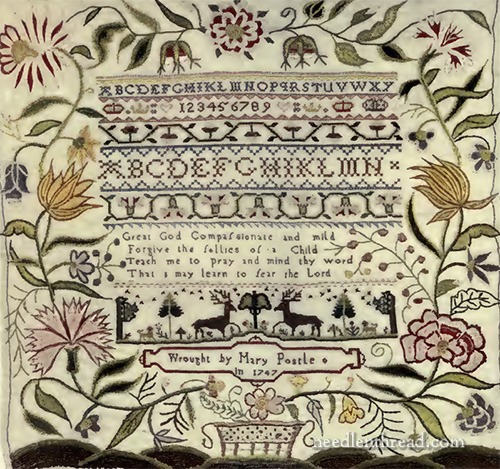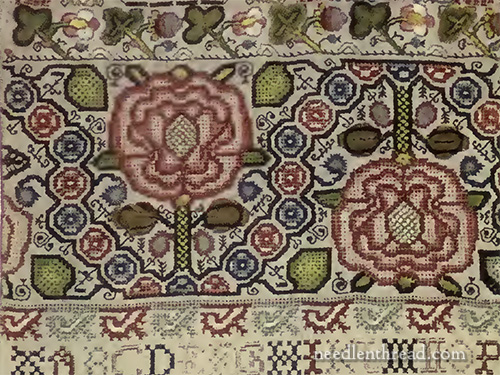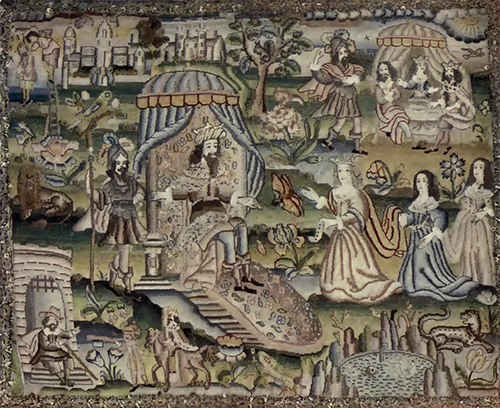Happy Friday – and happy weekend!
Gosh, we’ve been pummeled out here in the Midwest with bleak and rimey weather – maybe not quite frost (that comes tonight), but with wind and rain and chill. It’s been positively lovely! It’s always lovely when you don’t have to go out in it, right?
Just in case you’re stuck indoors this weekend, or even if you’re not, here’s a fabulous book on the history of samplers and tapestry embroideries that you might enjoy perusing. It’s truly a rabbit hole, if you have any interest at all in historical needlework, in sampler stitching, in embroidered tapestries, and the like. I enjoy it for its historical perspectives and its delving into the make-up of samplers.

The book is called Samplers and Tapestry Embroideries by Marcus Huish, published in 1913, and it is available online for free through Internet Archive, here.
You can view it online through that link, but I prefer instead to download the PDF. You’ll find the downloadable PDF on the right side of the screen below the book preview, under “Download Options.” Just scroll down to PDF. Once the PDF is on your computer, it’s easier to move around through it. It’s a 19.5 MB download – definitely worth the computer space!

From the beginning of the book, I was sucked right into actually reading the text and not just scrolling through for the illustration plates. (Ok, fine. Yes. I did that, too!)
In these days of sober personal attire, in which the adornment of our houses is almost entirely confined to the products of the loom, the absorbing interest which needlework possessed, and the almost entire possession which, in the Middle Ages, it took of the manual efforts of womankind, is apt to be lost sight of. In 1583, Stubbes, in his “Anatomy of Abuses,” wrote that the men were “decked out in fineries even to their shirts, which are wrought throughout with needlework of silke, curiously stitched with open seams and many other knacks besides,” and that it was impossible to tell who was a gentleman “because all persons dress indiscriminately in silks, velvets, satins, damasks, taffeties, and such like.” So, too, as regards the fair sex it was the same, from the Queen, who had no less than 2,000 dresses in her wardrobe, downwards. In France, almost at the same moment (in 1586), a petition was presented to Catherine de Medicis on “The Extreme Dearness of Living,” setting forth that “mills, lands, pastures, woods, and all the revenues are wasted on embroideries, insertions, trimming, tassels, fringes, hangings, gimps, needleworks, small chain stitchings, quiltings, back stitchings, etc., new diversities of which are invented daily.” Everyone worked with the needle. We read that the lady just named gathered round her her daughters, their cousins, and sometimes the exiled Marie Stuart, and passed a great portion of the time after dinner in needlework. A little later Madame de Maintenon worked at embroidery, not only in her apartments, but even when riding or driving she was “hardly fairly ensconced in her carriage than she pulled her needlework out of the bag she carried with her.”
When I got to the end of that, I couldn’t help thinking, Hm. I know people like that.
They always say history repeats itself. But I can’t really imagine stitching in a carriage. They always look quite luxurious on the silver screen, but the fact is, the shock systems were not quite the same…

I was drawn into the book pretty much from the beginning, and I’ve been reading it through. It’s fascinating and fun!
I especially love the section on the sampler inscriptions.
That self-conceit was not always considered a failing, is evident in the following verses:
“This needlework of mine may tell
That when a child I learned well
And by my elders I was taught
Not to spend my time for nought,”which is concentrated and intensified in one of Frances Johnson, worked 1797:
“In reading this if any faults you see
Mend them yourself and find no fault in me.”
Cheeky!
Samplers and Tapestry Embroideries is a wonderful – and free! – online resource, and it’s full of little inspirational bits, too, that might give you design ideas, maybe some avenues to explore if you’re looking for different types of needlework to try, and just some sometimes-entertaining insight into a slice of needlework history.
I hope you have a chance to look at it and enjoy it, too!
In Other News
If you haven’t had the opportunity to pick up your Mini Sampler Stockings embroidery kits, I still have a few available! I know it seems early, but with November upon us in a couple days, now’s the time to get your Christmas stitching underway. There is still time – the ornaments stitch up pretty quickly and they’re not to hard to finish. They make great cozy weekend projects!
If you are interested in a printed and spiral bound color copy of the Mini Sampler Stockings 33-page instructional book (for those who hesitate on the kit because the instructions are in a downloadable format), I’ve had a small number of booklets printed and bound. I’m making them available for the cost of the e-book + what it cost me to have them printed. Drop me a line if you’d like one or have questions.
Next week is November! Wow. Lot’s coming up – dragonfly wings and other things! Have a wonderful weekend!







Dear Mary
Samplers and Tapestry sounds like a fascinating book if the photos above are anything to go by and its lovely that it is free and available on line. Thank you for sharing with us the internet site. It’s great news that you have had a number of booklets made up for sale and that the mini sampler stockings are available. Thank you for sharing with us the Samplers and Tapestry online resource with us and how to access the book online. Have a good weekend.
Regards Anita Simmance
That’s an interesting looking read Mary, and I love the quotes! I’ll download that and enjoy having a browse.
Embroidery in a carriage. The first time I came to the United States I went with the friend I was visiting to the Spirit of Cross Stitch Festival in Knoxville, Tennessee. One lady I spoke with said that she took her current project with her everywhere and would place it on the passenger seat of her car. If she was stopped at a traffic light, she said she always managed to get two or three stitches done before the lights changed. I guess that is dedication but I wondered how drivers behind her felt about it.
I wonder if the needlework being done in carriages was actually knitting. Even today, I know people who call anything involving thread or yarn and needles of any sort, including knitting needles and crochet hooks, needlework. I was attempting to learn to knit at lunch one day, and a coworker said something about “my wife does cross stitch too!”. sigh, at least he didn’t bring up “grandma used to”, or make a “women’s work” comment.
Thanks for the book link – it has some lovely samplers.